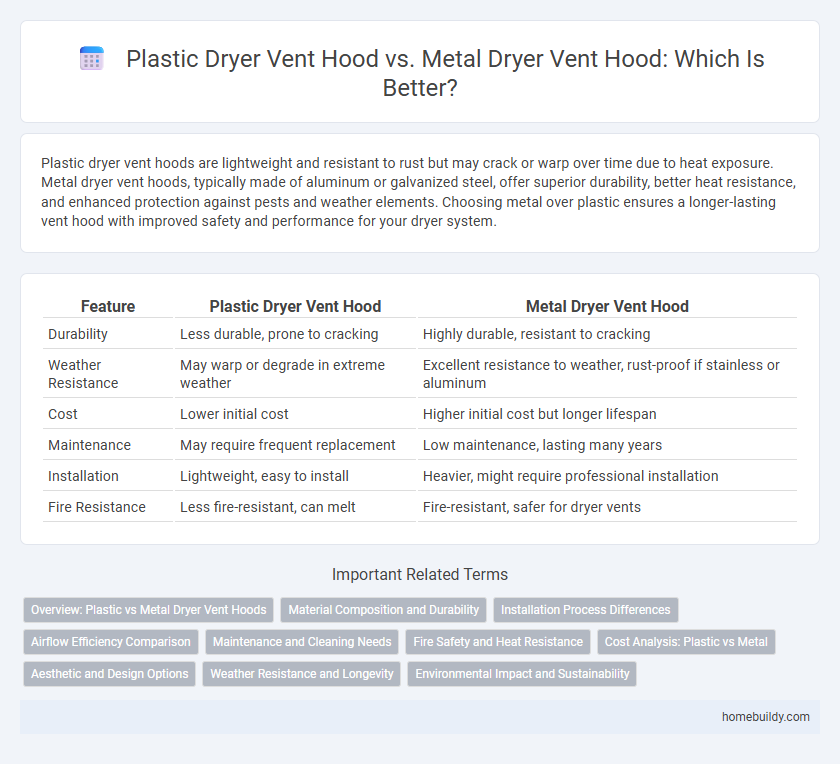Plastic dryer vent hoods are lightweight and resistant to rust but may crack or warp over time due to heat exposure. Metal dryer vent hoods, typically made of aluminum or galvanized steel, offer superior durability, better heat resistance, and enhanced protection against pests and weather elements. Choosing metal over plastic ensures a longer-lasting vent hood with improved safety and performance for your dryer system.
Table of Comparison
| Feature | Plastic Dryer Vent Hood | Metal Dryer Vent Hood |
|---|---|---|
| Durability | Less durable, prone to cracking | Highly durable, resistant to cracking |
| Weather Resistance | May warp or degrade in extreme weather | Excellent resistance to weather, rust-proof if stainless or aluminum |
| Cost | Lower initial cost | Higher initial cost but longer lifespan |
| Maintenance | May require frequent replacement | Low maintenance, lasting many years |
| Installation | Lightweight, easy to install | Heavier, might require professional installation |
| Fire Resistance | Less fire-resistant, can melt | Fire-resistant, safer for dryer vents |
Overview: Plastic vs Metal Dryer Vent Hoods
Plastic dryer vent hoods offer lightweight and corrosion-resistant options but are generally less durable and more prone to damage from heat or impact compared to metal vent hoods. Metal dryer vent hoods, typically made from aluminum or galvanized steel, provide enhanced durability, heat resistance, and long-term performance in various weather conditions. Choosing between plastic and metal dryer vent hoods depends on factors such as budget, environmental exposure, and desired lifespan of the vent system.
Material Composition and Durability
Plastic dryer vent hoods are lightweight and resistant to rust and corrosion but tend to be less durable and more prone to cracking under extreme temperatures or physical impact. Metal dryer vent hoods, typically made from aluminum or galvanized steel, offer superior strength and longevity, with excellent resistance to heat and weather wear. The choice of material significantly affects the vent hood's performance, lifespan, and maintenance needs, with metal options generally providing enhanced durability for long-term use.
Installation Process Differences
Plastic dryer vent hoods are lightweight and easier to handle during installation, requiring fewer specialized tools and often featuring snap-on or simple screw attachments. Metal dryer vent hoods demand more precise cutting and securing with metal screws or rivets, ensuring proper sealing to prevent air leaks and potential fire hazards. While plastic options offer quick setups, metal hoods provide enhanced durability and resistance to heat, influencing installation complexity and safety considerations.
Airflow Efficiency Comparison
Metal dryer vent hoods offer superior airflow efficiency due to their rigid structure and smooth interior surfaces, minimizing resistance and allowing warm, moist air to escape more freely. Plastic vent hoods tend to have higher airflow resistance because of their less rigid design and potential for warping, which can restrict air movement over time. Choosing metal vent hoods supports optimal dryer performance and reduces the risk of lint buildup, promoting safer and more effective ventilation.
Maintenance and Cleaning Needs
Plastic dryer vent hoods require more frequent cleaning due to their higher susceptibility to cracking and accumulating lint buildup, which can lead to blockages and reduced airflow. Metal dryer vent hoods, often made from aluminum or stainless steel, offer greater durability and easier maintenance since they resist damage from heat and physical impact, allowing for less frequent but thorough cleaning. Proper maintenance of both materials involves periodic inspection and removal of lint to ensure efficient dryer performance and prevent fire hazards.
Fire Safety and Heat Resistance
Metal dryer vent hoods offer superior fire safety and heat resistance compared to plastic models, as they are less likely to melt or ignite under high temperatures generated by dryer exhaust. Plastic vent hoods may warp or catch fire when exposed to prolonged heat, increasing the risk of fire hazards in residential settings. Choosing metal vent hoods, commonly made from aluminum or galvanized steel, enhances durability and reduces fire risk in dryer vent systems.
Cost Analysis: Plastic vs Metal
Plastic dryer vent hoods typically cost between $10 and $30, making them a budget-friendly option for homeowners. Metal dryer vent hoods, often made from aluminum or galvanized steel, range from $20 to $60, reflecting their durability and resistance to heat. While plastic options are cheaper upfront, metal vent hoods provide long-term value due to greater longevity and reduced maintenance expenses.
Aesthetic and Design Options
Plastic dryer vent hoods offer a variety of colors and finishes, allowing homeowners to choose options that blend seamlessly with their home's exterior design, enhancing curb appeal. Metal dryer vent hoods, typically made from aluminum or stainless steel, provide a sleek, modern appearance with a durable, polished finish that complements contemporary architectural styles. While plastic hoods prioritize versatility in color and shape, metal hoods excel in offering minimalist design options with superior resistance to weathering and discoloration.
Weather Resistance and Longevity
Plastic dryer vent hoods offer moderate weather resistance but tend to degrade faster under extreme temperatures and UV exposure, leading to cracking and brittleness over time. Metal dryer vent hoods, especially those made from galvanized steel or aluminum, provide superior durability and withstand harsh weather conditions without warping or rusting. Their longevity typically exceeds that of plastic counterparts, making metal vent hoods a preferred choice for sustained performance in variable climates.
Environmental Impact and Sustainability
Plastic dryer vent hoods contribute to environmental pollution due to their non-biodegradable nature and reliance on fossil fuels during production, leading to higher carbon emissions. Metal dryer vent hoods, especially those made from recycled aluminum or galvanized steel, offer greater sustainability through recyclability and longer lifespan, reducing waste and resource consumption. Choosing metal vent hoods supports eco-friendly building practices and minimizes overall environmental impact compared to plastic alternatives.
Plastic dryer vent hood vs metal dryer vent hood Infographic

 homebuildy.com
homebuildy.com